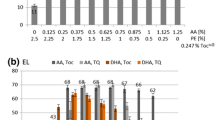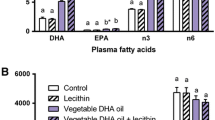Abstract
This study reports on the results of repeated gavages and dietary feeding of lutein dispersed either in phospholipids or fatty acid micelles or vegetable oils and the effects on lutein bioavailability and antioxidant enzymes in rats. For the gavage study, rats (n = 5/group) were intubated with lutein solubilized either in oleic acid (OLA, 18:1n-9) or linoleic acid (LNA, 18:2n-6) or phosphatidylcholine (PC) or lysophosphatidylcholine (LPC) or no phospholipid (NoPL) micelles for 10 days. For the dietary study, rats (n = 5/group) were fed a diet containing fenugreek leaf (lutein source), either with olive (OO) or sunflower (SFO) or groundnut (GNO, control) oil or l-α-lecithin (PL) for 4 weeks. The gavage study showed that the plasma, liver and eye lutein levels in OLA and LPC groups were higher by 23.9, 20.8 and 25.5% and 16.1, 28.5 and 14.0% than LNA and PC groups, respectively. The dietary study showed the plasma (35.0 and 43.5%) and eye (18.5 and 37.0%) lutein levels in OO were higher than SFO and GNO groups. The plasma and eye lutein levels in the PL group were higher by 20 and 31.3% than in the control. It is evident that OO and PL modulate lutein absorption, which in turn modulates antioxidant enzymes and fatty acids in plasma and tissues compared to SFO. Hence, selection of the fat source may be vital to enhancing the lutein bioavailability.
Similar content being viewed by others
Abbreviations
- GNO:
-
Groundnut oil
- LNA:
-
Linoleic acid
- LPC:
-
Lysophosphatidylcholine
- MDA:
-
Malonaldehyde
- OLA:
-
Oleic acid
- OO:
-
Olive oil
- PC:
-
Phosphatidylcholine
- PL:
-
l-α-Lecithin
- SFO:
-
Sunflower oil
- SOD:
-
Superoxide dismutase
References
Krinsky NI (2002) Possible biologic mechanisms for a protective role of xanthophylls. J Nutr 132:540S–542S
Handelman GJ, Nightingale ZD, Liechtenstein AH, Schaefer EJ, Blumberg JB (1999) Lutein and zeaxanthin concentration in plasma after dietary supplementation with egg yolk. Am J Clin Nutr 70:247–251
Herden E, Diaz V, Svanberg U (2002) Estimation of carotenoids accessibility from carrots determined by an in vitro digestion method. Eur J Clin Nutr 56:425–430
Dimitrov NV, Meyer C, Ulrey DE, Chenoweth W, Michelakis A, Malone W, Boone C, Fink G (1988) Bioavailability of β-carotene in humans. Am J Clin Nutr 48:298–304
Roodenberg AJC, Leenen R, Van het hof KH, Westsrate JA, Tijburg LBM (2000) Amount of fat in the diet affects bioavailability of lutein esters but not of β-carotene, and vitamin-E in humans. Am J Clin Nutr 71:1187–1193
Van het Hof KH, West CE, Weststrate JA, Hautvast JGA (2000) Dietary factors that affect the bioavailability of carotenoids. J Nutr 130:503–506
Baskaran V, Sugawara T, Nagao A (2003) Phospholipids affect the intestinal absorption of carotenoids in mice. Lipids 38:705–711
Raju M, Lakshminarayana R, Krishnakantha TP, Baskaran V (2005) Influence of phospholipids on β-carotene absorption and conversion into vitamin A in rats. J Nutr Sci Vitaminol 51:216–222
Sugawara T, Kushiro M, Zhang H, Nara E, Ono H, Nagao A (2001) Lysophosphatidylcholine enhances carotenoid uptake from mixed micelles by Caco-2 human intestinal cells. J Nutr 131:2921–2927
Hu X, Jandacek RJ, White WS (2000) Intestinal absorption of β-carotene ingested with a meal rich in sunflower oil or beef tallow: postprandial appearance in triacylglycerol-rich lipoproteins in women. Am J Clin Nutr 71:1170–1180
Clark RM, Yao L, She L, Furr HC (2000) A comparison of lycopene and astaxanthin absorption from corn oil and olive oil emulsions. Lipids 37:803–806
Lakshminarayana R, Raju M, Krishnakantha TP, Baskaran V (2006) Enhanced bioavailability of lutein by lyso-phosphatidylcholine in mixed micelles. Mol Cell Biochem 281:103–110
Lakshminarayana R, Raju M, Krishnakantha TP, Baskaran V (2007) Lutein and zeaxanthin in leafy greens and their bioavailability: olive oil influences the absorption of dietary lutein and its accumulation in adult rats. J Agric Food Chem 55:6395–6400
Report (1977) of the American Institute of Nutrition Ad. Hoc committee on standards for nutritional studies. J Nutr 170:1340–1348
Flohe L, Otting F (1984) Superoxide dismutase assays. Methods Enzymol 105:93–104
Flohe L, Gunzler W (1984) Assays of glutathione peroxidase. Methods Enzymol 105:114–121
Owens CWI, Belcher RV (1965) A colorimetric micro-method for the determination of glutathione. Biochem J 94:705–711
Lowry OH, Rosebrough NJ, Farr AL, Randall RJ (1951) Protein estimation with Folin phenol reagent. J Biol Chem 193:265–275
Ohkawa H, Ohishi N, Yagi H (1979) Assay for lipid peroxides in animal tissues by thiobarbituric acid reaction. Anal Biochem 95:351–358
Folch J, Lee M, Sloane SGH (1957) A simple method for isolation and purification of total lipids from animal tissue. J Biol Chem 226:497–509
Fletcher MJ (1968) A colorimetric method for estimating serum triacylglycerol. Clin Chem Acta 22:303–307
Searcy RL, Bergquist LM (1960) A new color reaction for the quantification of serum cholesterol. Clin Chem Acta 5:192–196
Stewart JCM (1980) Colorimetric estimation of phospholipids with ammonium ferrothiocyanate. Anal Biochem 104:10–14
Morrison MR, Smith M (1963) Preparation of fatty acids methyl esters and dimethyl acetyls from lipids with boron fluoride methanol. J Lipid Res 5:600–608
Homan R, Hamlehle KL (1998) Phospholipase A2 relieves phosphatidylcholine inhibition of micellar cholesterol absorption and transport by human intestinal cell line Caco-2. J Lipid Res 39:1197–1209
Borel P, Grolier P, Armand M, Partier A, Lafont H, Lairon D, Azais-Braesco V (1996) Carotenoids in biological emulsions: solubility, surface-to-core distribution and release from lipid droplets. J Lipid Res 37:250–261
Hollander D, Ruble PE (1978) β-Carotene intestinal absorption: bile, fatty acids, pH and flow rate effects on transport. Am J Physiol 235:E686–E691
Borel P, Tyssandier V, Mekki N, Grolier P, Rochette Y, Alexandre-Gouabau MC, Azais-Braesco V (1998) Chylomicron β-carotene and retinyl palmitate responses are dramatically diminished when men ingest β-carotene with medium-chain rather than long-chain triglycerides. J Nutr 128:1361–1367
Odeberg JM, Lingnell A, Pettersson A, Hoglund P (2003) Oral bioavailability of the antioxidant astaxanthin in humans is enhanced by incorporation of lipid based formulations. Eur J Pharm Sci 19:299–304
Mataix J, Quiles JL, Huertas JR, Battino M, Manas M (1998) Tissue specific interactions of exercise, dietary fatty acids and vitamin-E in lipid peroxidation. Free Radic Biol Med 24:511–521
Ruiz-Gutierrez V, Perez-Espinosa A, Vazquez CM, Santa-Maria C (1999) Effect of dietary fats (fish, olive and high-oleic acid sunflower oils) on lipid composition and antioxidant enzymes in rat liver. Br J Nutr 82:233–241
Cai J, Nelson KC, Wu M, Steinberg P Jr, Jones DP (2000) Oxidative damage and protection of the retinal pigment epithelium. Prog Ret Eye Res 19:205–221
Acknowledgment
The authors thank the Director and Head, Department of Biochemistry and Nutrition, CFTRI for their encouragement. R. Lakshminarayana and M. Raju acknowledge the CSIR, New Delhi, India for the granting of Senior Research Fellowships.
Author information
Authors and Affiliations
Corresponding author
About this article
Cite this article
Lakshminarayana, R., Raju, M., Keshava Prakash, M.N. et al. Phospholipid, Oleic Acid Micelles and Dietary Olive Oil Influence the Lutein Absorption and Activity of Antioxidant Enzymes in Rats. Lipids 44, 799–806 (2009). https://doi.org/10.1007/s11745-009-3328-0
Received:
Accepted:
Published:
Issue Date:
DOI: https://doi.org/10.1007/s11745-009-3328-0




